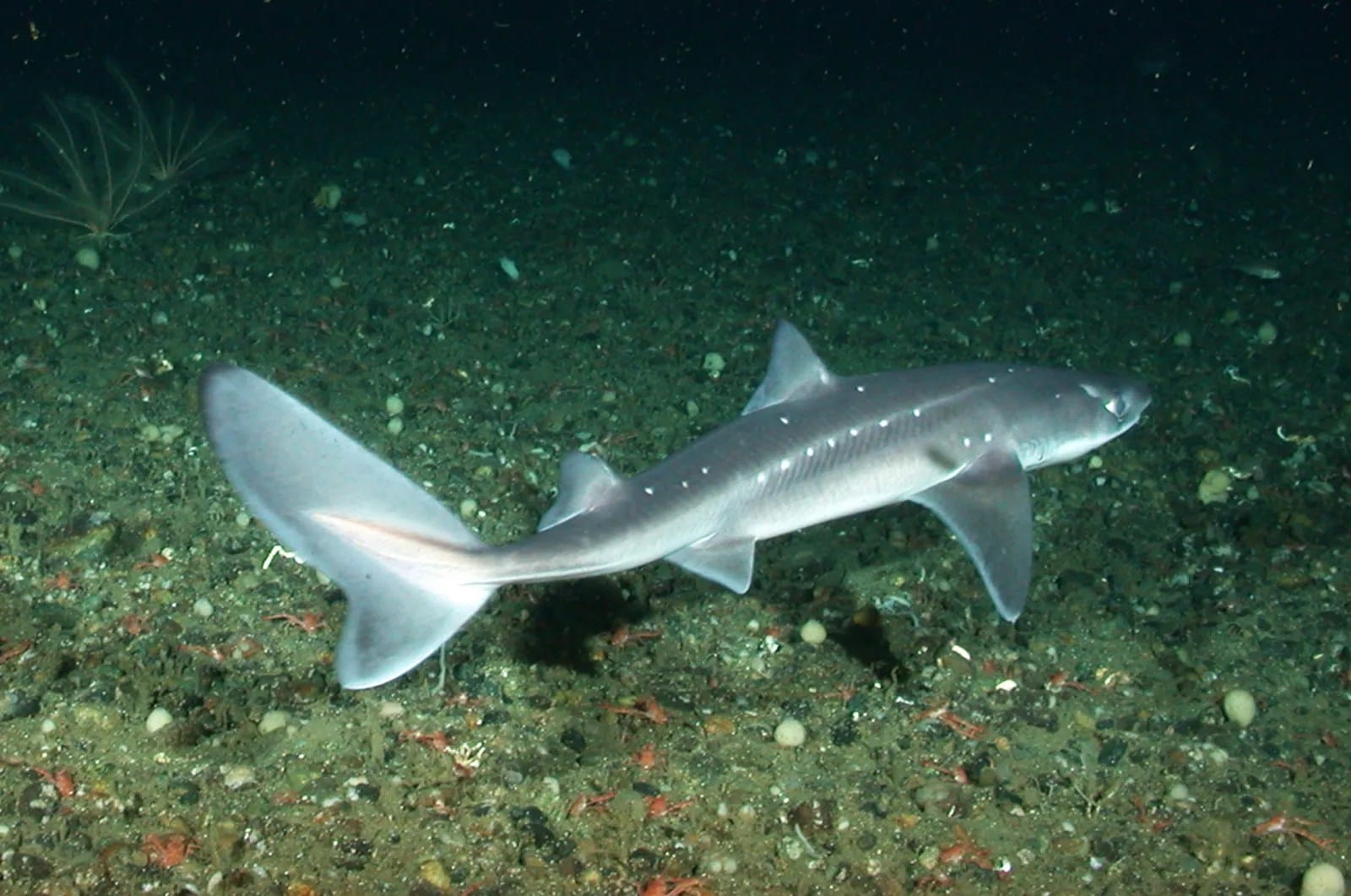Dive into the ocean’s depths and meet the viper dogfish, a creature as captivating as it is mysterious. This deep-sea dweller, with its otherworldly appearance and elusive habits, offers a glimpse into the wonders hidden within our planet’s most unexplored realm.
Viper Dogfish: A Deep Dive into Darkness
Imagine a shark so bizarre, it seems plucked from the pages of science fiction. That’s the viper dogfish, a denizen of the Pacific Ocean’s inky depths. This enigmatic creature, though shrouded in mystery, is slowly revealing its secrets to the world.
The viper dogfish defies typical shark expectations. Picture a slender body with an almost endearingly stubby snout—until you reach the jaws. These jaws, capable of extending outward with startling agility, are lined with long, needle-like teeth, perfectly designed for piercing scales and securing a meal in the abyss.
Adding to its mystique, the viper dogfish possesses bioluminescence, the ability to generate its own light. This underwater light show is thought to play a role in attracting prey or even communicating with others of its kind in the vast darkness.
Life in the deep sea presents immense challenges—crushing pressure, frigid temperatures, and near-total darkness. Yet, the viper dogfish thrives. Over millennia, it has evolved remarkable adaptations, including a body built to withstand immense pressure and eyes acutely sensitive to the faintest glimmers of light.
Though we know the viper dogfish to be a predator, favoring bony fish and crustaceans, its precise role in the deep-sea food web is still being unraveled. Scientists suspect it plays a vital role in maintaining a healthy balance, keeping populations in check.
The viper dogfish’s elusive nature, coupled with the challenges of deep-sea exploration, makes studying these creatures exceptionally difficult. This lack of data presents challenges for conservationists, making it difficult to assess the health of their populations and determine if they face any major threats. However, like many deep-sea inhabitants, they could be impacted by habitat changes and accidental capture in deep-sea fishing gear.
Fortunately, scientists remain undeterred. Research on the viper dogfish is ongoing, with experts eager to uncover more about its biology, behavior, and its place in the larger ecosystem. Each new piece of information brings us closer to understanding this enigmatic creature and ensuring its survival in a rapidly changing world. Who knows what other secrets this mysterious shark of the deep might hold? The viper dogfish serves as a potent reminder that we’ve only just begun to explore the ocean’s depths and its boundless capacity for wonder.
Viper Dogfish Size: Unmasking the Deep’s Miniature Predator
The viper dogfish, a creature with a name that evokes fearsome images, might surprise you with its actual size. These sharks, far from being titans of the deep, are surprisingly small.
The average viper dogfish is no larger than a standard ruler, reaching a maximum recorded length of just 21 inches. Adding to the intrigue, female viper dogfish tend to outgrow their male counterparts, with the largest recorded female measuring 1.8 feet long—not much bigger than a loaf of bread! Despite their size, these sharks are incredibly lightweight, with the record-holding female weighing in at a mere 1.7 pounds.
Don’t let their small size fool you, though. Viper dogfish are incredibly efficient predators. Their secret weapons? Extendable jaws reminiscent of a science fiction creature and needle-sharp teeth—a fearsome combination for any unsuspecting prey.
Viper Dogfish Diet Deep Dive: Unlocking the Secrets of a Deep-Sea Predator
Living in the depths of the Pacific Ocean, the viper dogfish has adapted to a diet that reflects its extreme environment. These sharks are opportunistic feeders, primarily targeting small fish, especially the bioluminescent lanternfish that share their dark habitat. Their needle-like teeth are perfectly designed for grasping and swallowing these small fish whole.
While their diet primarily consists of fish, viper dogfish are not picky eaters. They will also consume crustaceans like shrimp and even the occasional small squid.
Direct observation of their feeding habits is challenging due to their remote habitat. Scientists rely on stomach content analysis and inferences from their physical adaptations to piece together their diet. Some experts believe viper dogfish are ambush predators, utilizing their own bioluminescence to lure unsuspecting prey in the pitch-black darkness. Adding to their predatory prowess, their extendable jaws and incredibly flexible stomachs allow them to consume prey larger than themselves!
Though small in size, these deep-sea diners play a crucial role in the intricate food web of the ocean depths. As mid-level predators, they occupy a vital link, transferring energy from smaller organisms to larger predators like tuna, maintaining the delicate balance of this complex ecosystem.
Are Viper Dogfish Extinct? Unveiling the Truth About This Elusive Shark
Despite their fearsome name, elusive nature, and the aura of mystery surrounding them, viper dogfish are not extinct. They are classified as “Least Concern” by conservationists, indicating that their populations are currently considered stable.
However, their deep-sea habitat makes them inherently vulnerable to environmental changes, such as pollution and habitat degradation. Additionally, they can be accidentally caught in fishing gear intended for other species, potentially impacting their numbers.
Scientists are actively working to unravel the mysteries surrounding the viper dogfish. How do they navigate and find mates in the pitch-black depths? What are the nuances of their life cycle and reproductive behavior? Each new discovery sheds light on these fascinating creatures and contributes to their conservation.
If you’re interested in learning more about the fascinating creatures that inhabit our world, be sure to check out our latest article on the invasive tawny crazy ants that have been wreaking havoc on our local ecosystem. Additionally, if you’ve ever spotted a tufted ground squirrel scampering about in your backyard, we have a fascinating article that will delve into the unique behaviors and habits of these adorable creatures.
















